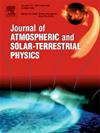Thermodynamic control of lightning activity in premonsoon and monsoon season over the Indian region
IF 1.8
4区 地球科学
Q3 GEOCHEMISTRY & GEOPHYSICS
Journal of Atmospheric and Solar-Terrestrial Physics
Pub Date : 2024-12-24
DOI:10.1016/j.jastp.2024.106410
引用次数: 0
Abstract
Understanding the relationship between lightning activity and atmospheric thermodynamics is important for improving thunderstorm forecasting and mitigating lightning-related hazards. The study investigates the linkage between lightning activity and thermodynamic indices over the Indian subcontinent during pre-monsoon and monsoon seasons across 17 years (1998–2014). The flash count data was obtained from the Tropical Rainfall Measuring Mission's (TRMM) Lightning Imaging Sensor (LIS); the upper air sounding data for thermodynamic indices was archived from the University of Wyoming. Additionally, air temperature and relative humidity data at various pressure levels were retrieved from the National Oceanic and Atmospheric Administration (NOAA) during the same period over the Indian region. In the present study, the results indicate that the flash counts, surface maximum temperature, and Deep Convective Index (DCI) show a high peak in the month of May, before the onset of monsoon season. The higher peak of surface maximum temperature and DCI value is associated with strong convection which plays a crucial role in the occurrence of high lightning activity. The Bowen ratio (BR), planetary boundary layer (PBL), and Vertical Total Index (VTI) show a high peak in May. These are because of increased sensible heat flux and a strong vertical lapse rate. The PBL and high Cross Total Index (CTI) values contribute to more lightning strikes during the pre-monsoon season. The decrease in flash count and thermodynamic indices after the onset of monsoon season is due to the transport of more moisture from the ocean into the free atmosphere, large cloud coverage, shallow convection, slow charging mechanism, low cloud electrification and hence low lightning activity. The present study underscores the importance of evaluating threshold values of thermodynamic indices during seasonal transitions (premonsoon to monsoon season), which is useful for predicting the severity of thunderstorm formation and lightning intensity over the Indian region.
印度地区季风前和季风期闪电活动的热力控制
了解闪电活动与大气热力学之间的关系对于提高雷暴预报和减轻雷暴相关危害具有重要意义。该研究调查了17年(1998-2014)季风前和季风季节印度次大陆闪电活动与热力学指数之间的联系。闪电计数数据来自热带降雨测量任务(TRMM)的闪电成像传感器(LIS);热力指数的高空探测数据存档于怀俄明大学。此外,从美国国家海洋和大气管理局(NOAA)检索了同一时期印度地区不同压力水平下的气温和相对湿度数据。研究结果表明,在季风季节开始前的5月份,闪数、地表最高温度和深对流指数(DCI)均出现高峰。地表最高温度和DCI值的峰值较高,与强对流有关,强对流对高闪电活动的发生起着至关重要的作用。波文比(BR)、行星边界层(PBL)和垂直总指数(VTI)在5月出现高峰。这是由于感热通量增加和强烈的垂直递减率。在季风前季节,PBL和高交叉总指数(CTI)值导致了更多的雷击。季风季节开始后闪电次数和热力指数的减少是由于更多的水汽从海洋输送到自由大气,云层覆盖面积大,对流浅,充电机制缓慢,云电气化低,因此闪电活动低。本研究强调了在季节转换期间(季风前到季风季节)评估热力学指数阈值的重要性,这对于预测印度地区雷暴形成的严重程度和闪电强度是有用的。
本文章由计算机程序翻译,如有差异,请以英文原文为准。
求助全文
约1分钟内获得全文
求助全文
来源期刊

Journal of Atmospheric and Solar-Terrestrial Physics
地学-地球化学与地球物理
CiteScore
4.10
自引率
5.30%
发文量
95
审稿时长
6 months
期刊介绍:
The Journal of Atmospheric and Solar-Terrestrial Physics (JASTP) is an international journal concerned with the inter-disciplinary science of the Earth''s atmospheric and space environment, especially the highly varied and highly variable physical phenomena that occur in this natural laboratory and the processes that couple them.
The journal covers the physical processes operating in the troposphere, stratosphere, mesosphere, thermosphere, ionosphere, magnetosphere, the Sun, interplanetary medium, and heliosphere. Phenomena occurring in other "spheres", solar influences on climate, and supporting laboratory measurements are also considered. The journal deals especially with the coupling between the different regions.
Solar flares, coronal mass ejections, and other energetic events on the Sun create interesting and important perturbations in the near-Earth space environment. The physics of such "space weather" is central to the Journal of Atmospheric and Solar-Terrestrial Physics and the journal welcomes papers that lead in the direction of a predictive understanding of the coupled system. Regarding the upper atmosphere, the subjects of aeronomy, geomagnetism and geoelectricity, auroral phenomena, radio wave propagation, and plasma instabilities, are examples within the broad field of solar-terrestrial physics which emphasise the energy exchange between the solar wind, the magnetospheric and ionospheric plasmas, and the neutral gas. In the lower atmosphere, topics covered range from mesoscale to global scale dynamics, to atmospheric electricity, lightning and its effects, and to anthropogenic changes.
 求助内容:
求助内容: 应助结果提醒方式:
应助结果提醒方式:


